Significance of Critical Thinking Skills in Nursing Practice
VerifiedAdded on 2020/04/21
|11
|3523
|168
Essay
AI Summary
This essay critically examines the significance of critical thinking skills in nursing practice, emphasizing its role in the nursing process and its impact on patient outcomes. The paper defines critical thinking, highlighting skills such as critical analysis, inference, and evaluation of information sources. Clinical examples, including scenarios involving pain management and patient assessment, illustrate the application of critical thinking in hospital settings. The essay also addresses potential pitfalls in critical thinking, such as logical fallacies and generalization errors, and emphasizes the importance of evidence-based practice. The discussion underscores the need for nurses to develop and apply critical thinking skills to ensure safe, efficient, and effective patient care.

1Running head: NURSING
Nursing
Name of student:
Name of university:
Author note:
Nursing
Name of student:
Name of university:
Author note:
Paraphrase This Document
Need a fresh take? Get an instant paraphrase of this document with our AI Paraphraser
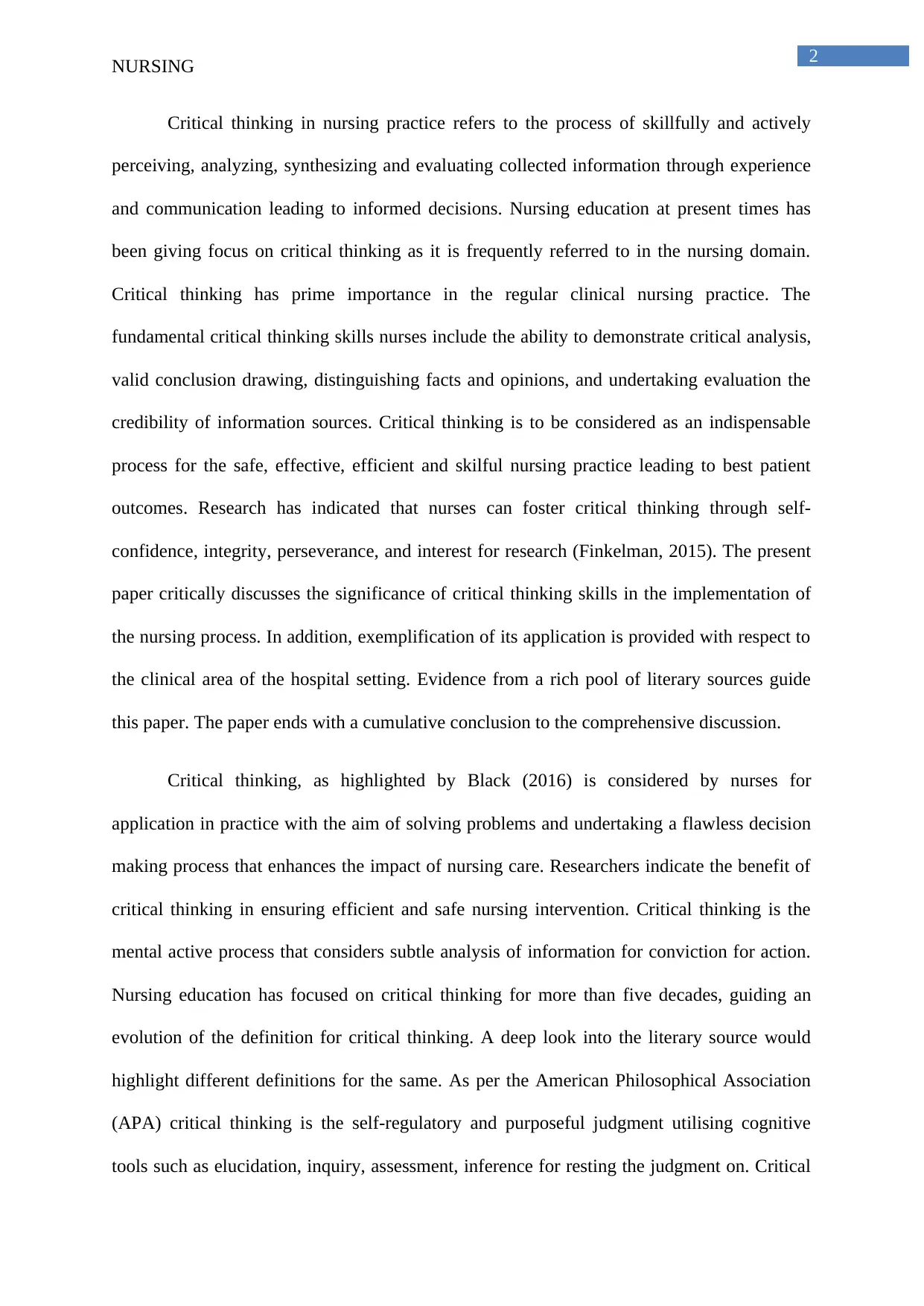
2
NURSING
Critical thinking in nursing practice refers to the process of skillfully and actively
perceiving, analyzing, synthesizing and evaluating collected information through experience
and communication leading to informed decisions. Nursing education at present times has
been giving focus on critical thinking as it is frequently referred to in the nursing domain.
Critical thinking has prime importance in the regular clinical nursing practice. The
fundamental critical thinking skills nurses include the ability to demonstrate critical analysis,
valid conclusion drawing, distinguishing facts and opinions, and undertaking evaluation the
credibility of information sources. Critical thinking is to be considered as an indispensable
process for the safe, effective, efficient and skilful nursing practice leading to best patient
outcomes. Research has indicated that nurses can foster critical thinking through self-
confidence, integrity, perseverance, and interest for research (Finkelman, 2015). The present
paper critically discusses the significance of critical thinking skills in the implementation of
the nursing process. In addition, exemplification of its application is provided with respect to
the clinical area of the hospital setting. Evidence from a rich pool of literary sources guide
this paper. The paper ends with a cumulative conclusion to the comprehensive discussion.
Critical thinking, as highlighted by Black (2016) is considered by nurses for
application in practice with the aim of solving problems and undertaking a flawless decision
making process that enhances the impact of nursing care. Researchers indicate the benefit of
critical thinking in ensuring efficient and safe nursing intervention. Critical thinking is the
mental active process that considers subtle analysis of information for conviction for action.
Nursing education has focused on critical thinking for more than five decades, guiding an
evolution of the definition for critical thinking. A deep look into the literary source would
highlight different definitions for the same. As per the American Philosophical Association
(APA) critical thinking is the self-regulatory and purposeful judgment utilising cognitive
tools such as elucidation, inquiry, assessment, inference for resting the judgment on. Critical
NURSING
Critical thinking in nursing practice refers to the process of skillfully and actively
perceiving, analyzing, synthesizing and evaluating collected information through experience
and communication leading to informed decisions. Nursing education at present times has
been giving focus on critical thinking as it is frequently referred to in the nursing domain.
Critical thinking has prime importance in the regular clinical nursing practice. The
fundamental critical thinking skills nurses include the ability to demonstrate critical analysis,
valid conclusion drawing, distinguishing facts and opinions, and undertaking evaluation the
credibility of information sources. Critical thinking is to be considered as an indispensable
process for the safe, effective, efficient and skilful nursing practice leading to best patient
outcomes. Research has indicated that nurses can foster critical thinking through self-
confidence, integrity, perseverance, and interest for research (Finkelman, 2015). The present
paper critically discusses the significance of critical thinking skills in the implementation of
the nursing process. In addition, exemplification of its application is provided with respect to
the clinical area of the hospital setting. Evidence from a rich pool of literary sources guide
this paper. The paper ends with a cumulative conclusion to the comprehensive discussion.
Critical thinking, as highlighted by Black (2016) is considered by nurses for
application in practice with the aim of solving problems and undertaking a flawless decision
making process that enhances the impact of nursing care. Researchers indicate the benefit of
critical thinking in ensuring efficient and safe nursing intervention. Critical thinking is the
mental active process that considers subtle analysis of information for conviction for action.
Nursing education has focused on critical thinking for more than five decades, guiding an
evolution of the definition for critical thinking. A deep look into the literary source would
highlight different definitions for the same. As per the American Philosophical Association
(APA) critical thinking is the self-regulatory and purposeful judgment utilising cognitive
tools such as elucidation, inquiry, assessment, inference for resting the judgment on. Critical

3
NURSING
thinking also upholds explanation of the methodological, evidential, criteriological,
conceptual, or contextual clinical considerations. A more general explanation for critical
thinking has been given by (DiCenso et al., 2014). As per the authors, critical thinking is the
self-monitored, self-directed, self-corrective and self-disciplined thinking. It acts by
supposing assent to arduous standards of quality care. In addition, it entails effective
communication and problem solving capabilities. Nurses showing critical thinking abilities
are expected to overcome socio-centrism and egocentrism. All nurses are expected to develop
a good habit of showing. However, they are not in a position to escape the fundamental
structures of the clinical traditions and practices that guide clinical decision making under
certain conditions.
LoBiondo-Wood et al., (2013) opined that a set of skills are to be cultivated by a
nurse in order to demonstrate critical thinking skills. These encompass critical analysis,
introductory and concluding justification, valid conclusion, distinguishing facts and opinions
to assess the credibility of sources of information, clarification of concepts, and recognition
conditions. Critical analysis refers to the process of asking questions to determine the
difference between ideas that are necessary and unnecessary. Such an analysis is necessary
for extracting out the important ideas and information. This thus rationalizes any certain idea
that determines what is appropriate and what is not. Two other critical thinking skills are the
inference and concluding justification. When justification is upheld for inductive
generalizations from a large set of observations and data, a unique interpretation can be
formed. Justification, however, is to be formed from the general concept to something
specific. In the process of critical thinking, a nurse is to discriminate and analyze prerogatives
on the basis of facts, opinions, conclusions and judgments. A primitive stage of critical
thinking is assessment. This refers to the action of confirming the correctness and truthfulness
NURSING
thinking also upholds explanation of the methodological, evidential, criteriological,
conceptual, or contextual clinical considerations. A more general explanation for critical
thinking has been given by (DiCenso et al., 2014). As per the authors, critical thinking is the
self-monitored, self-directed, self-corrective and self-disciplined thinking. It acts by
supposing assent to arduous standards of quality care. In addition, it entails effective
communication and problem solving capabilities. Nurses showing critical thinking abilities
are expected to overcome socio-centrism and egocentrism. All nurses are expected to develop
a good habit of showing. However, they are not in a position to escape the fundamental
structures of the clinical traditions and practices that guide clinical decision making under
certain conditions.
LoBiondo-Wood et al., (2013) opined that a set of skills are to be cultivated by a
nurse in order to demonstrate critical thinking skills. These encompass critical analysis,
introductory and concluding justification, valid conclusion, distinguishing facts and opinions
to assess the credibility of sources of information, clarification of concepts, and recognition
conditions. Critical analysis refers to the process of asking questions to determine the
difference between ideas that are necessary and unnecessary. Such an analysis is necessary
for extracting out the important ideas and information. This thus rationalizes any certain idea
that determines what is appropriate and what is not. Two other critical thinking skills are the
inference and concluding justification. When justification is upheld for inductive
generalizations from a large set of observations and data, a unique interpretation can be
formed. Justification, however, is to be formed from the general concept to something
specific. In the process of critical thinking, a nurse is to discriminate and analyze prerogatives
on the basis of facts, opinions, conclusions and judgments. A primitive stage of critical
thinking is assessment. This refers to the action of confirming the correctness and truthfulness
⊘ This is a preview!⊘
Do you want full access?
Subscribe today to unlock all pages.

Trusted by 1+ million students worldwide
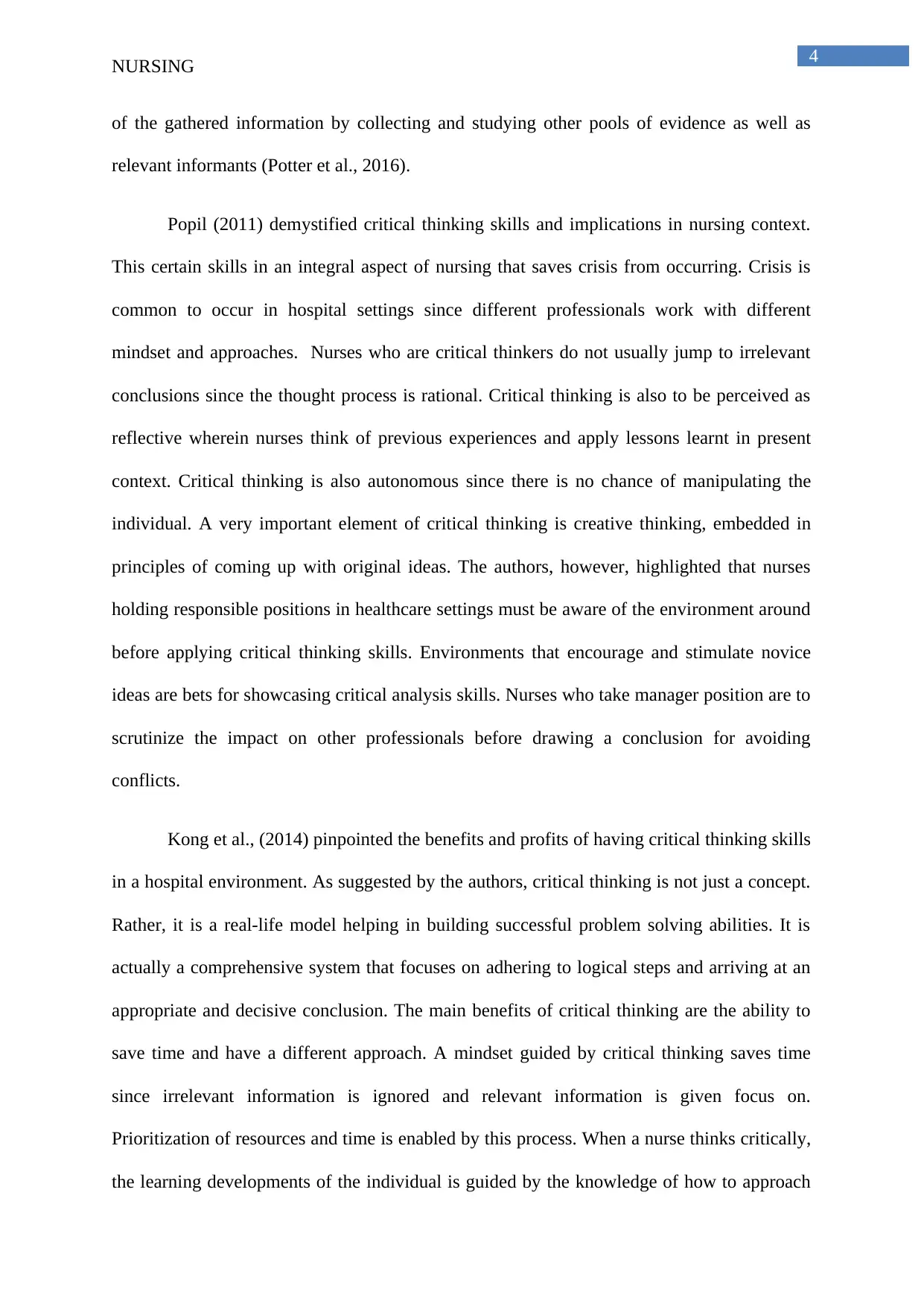
4
NURSING
of the gathered information by collecting and studying other pools of evidence as well as
relevant informants (Potter et al., 2016).
Popil (2011) demystified critical thinking skills and implications in nursing context.
This certain skills in an integral aspect of nursing that saves crisis from occurring. Crisis is
common to occur in hospital settings since different professionals work with different
mindset and approaches. Nurses who are critical thinkers do not usually jump to irrelevant
conclusions since the thought process is rational. Critical thinking is also to be perceived as
reflective wherein nurses think of previous experiences and apply lessons learnt in present
context. Critical thinking is also autonomous since there is no chance of manipulating the
individual. A very important element of critical thinking is creative thinking, embedded in
principles of coming up with original ideas. The authors, however, highlighted that nurses
holding responsible positions in healthcare settings must be aware of the environment around
before applying critical thinking skills. Environments that encourage and stimulate novice
ideas are bets for showcasing critical analysis skills. Nurses who take manager position are to
scrutinize the impact on other professionals before drawing a conclusion for avoiding
conflicts.
Kong et al., (2014) pinpointed the benefits and profits of having critical thinking skills
in a hospital environment. As suggested by the authors, critical thinking is not just a concept.
Rather, it is a real-life model helping in building successful problem solving abilities. It is
actually a comprehensive system that focuses on adhering to logical steps and arriving at an
appropriate and decisive conclusion. The main benefits of critical thinking are the ability to
save time and have a different approach. A mindset guided by critical thinking saves time
since irrelevant information is ignored and relevant information is given focus on.
Prioritization of resources and time is enabled by this process. When a nurse thinks critically,
the learning developments of the individual is guided by the knowledge of how to approach
NURSING
of the gathered information by collecting and studying other pools of evidence as well as
relevant informants (Potter et al., 2016).
Popil (2011) demystified critical thinking skills and implications in nursing context.
This certain skills in an integral aspect of nursing that saves crisis from occurring. Crisis is
common to occur in hospital settings since different professionals work with different
mindset and approaches. Nurses who are critical thinkers do not usually jump to irrelevant
conclusions since the thought process is rational. Critical thinking is also to be perceived as
reflective wherein nurses think of previous experiences and apply lessons learnt in present
context. Critical thinking is also autonomous since there is no chance of manipulating the
individual. A very important element of critical thinking is creative thinking, embedded in
principles of coming up with original ideas. The authors, however, highlighted that nurses
holding responsible positions in healthcare settings must be aware of the environment around
before applying critical thinking skills. Environments that encourage and stimulate novice
ideas are bets for showcasing critical analysis skills. Nurses who take manager position are to
scrutinize the impact on other professionals before drawing a conclusion for avoiding
conflicts.
Kong et al., (2014) pinpointed the benefits and profits of having critical thinking skills
in a hospital environment. As suggested by the authors, critical thinking is not just a concept.
Rather, it is a real-life model helping in building successful problem solving abilities. It is
actually a comprehensive system that focuses on adhering to logical steps and arriving at an
appropriate and decisive conclusion. The main benefits of critical thinking are the ability to
save time and have a different approach. A mindset guided by critical thinking saves time
since irrelevant information is ignored and relevant information is given focus on.
Prioritization of resources and time is enabled by this process. When a nurse thinks critically,
the learning developments of the individual is guided by the knowledge of how to approach
Paraphrase This Document
Need a fresh take? Get an instant paraphrase of this document with our AI Paraphraser
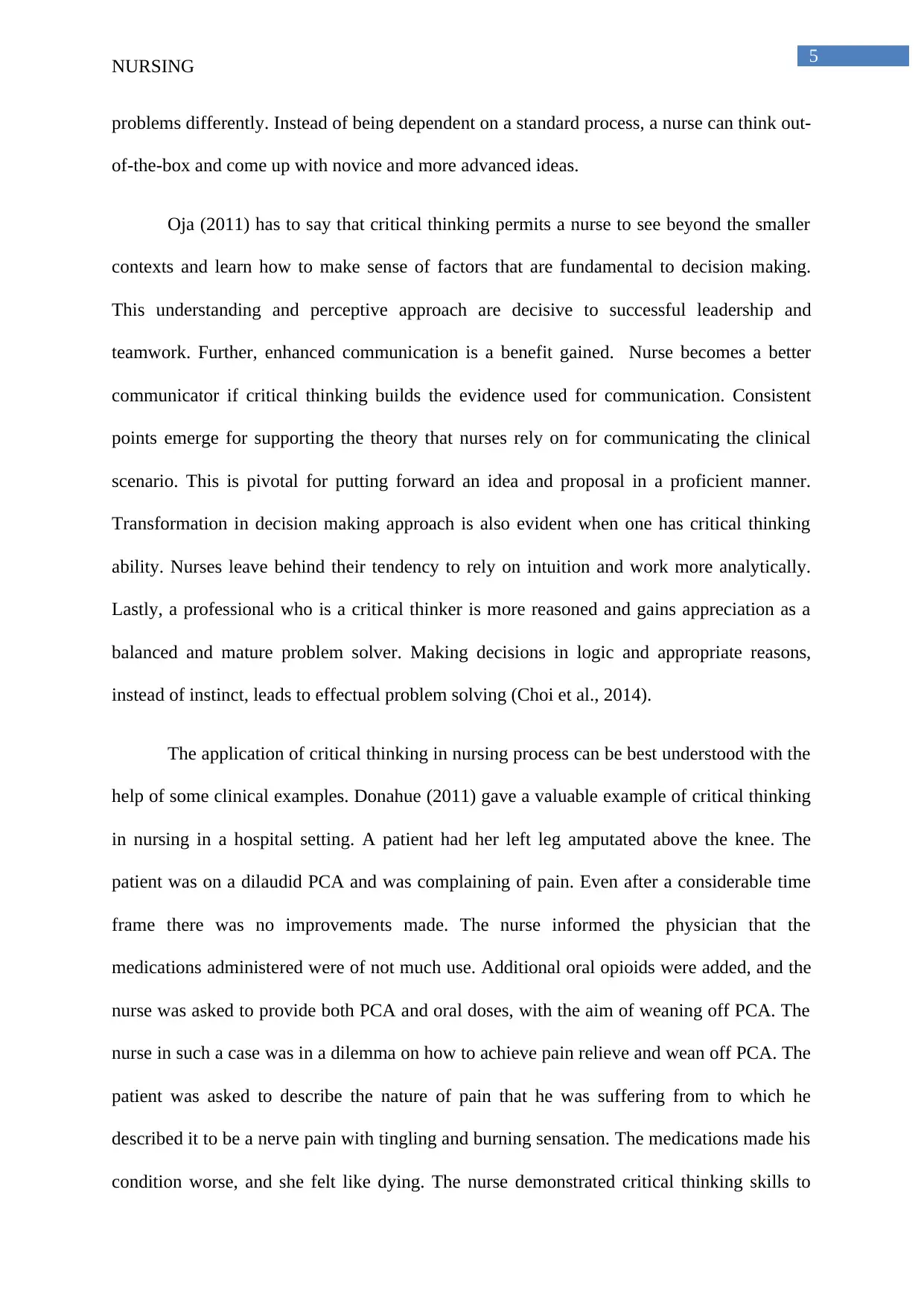
5
NURSING
problems differently. Instead of being dependent on a standard process, a nurse can think out-
of-the-box and come up with novice and more advanced ideas.
Oja (2011) has to say that critical thinking permits a nurse to see beyond the smaller
contexts and learn how to make sense of factors that are fundamental to decision making.
This understanding and perceptive approach are decisive to successful leadership and
teamwork. Further, enhanced communication is a benefit gained. Nurse becomes a better
communicator if critical thinking builds the evidence used for communication. Consistent
points emerge for supporting the theory that nurses rely on for communicating the clinical
scenario. This is pivotal for putting forward an idea and proposal in a proficient manner.
Transformation in decision making approach is also evident when one has critical thinking
ability. Nurses leave behind their tendency to rely on intuition and work more analytically.
Lastly, a professional who is a critical thinker is more reasoned and gains appreciation as a
balanced and mature problem solver. Making decisions in logic and appropriate reasons,
instead of instinct, leads to effectual problem solving (Choi et al., 2014).
The application of critical thinking in nursing process can be best understood with the
help of some clinical examples. Donahue (2011) gave a valuable example of critical thinking
in nursing in a hospital setting. A patient had her left leg amputated above the knee. The
patient was on a dilaudid PCA and was complaining of pain. Even after a considerable time
frame there was no improvements made. The nurse informed the physician that the
medications administered were of not much use. Additional oral opioids were added, and the
nurse was asked to provide both PCA and oral doses, with the aim of weaning off PCA. The
nurse in such a case was in a dilemma on how to achieve pain relieve and wean off PCA. The
patient was asked to describe the nature of pain that he was suffering from to which he
described it to be a nerve pain with tingling and burning sensation. The medications made his
condition worse, and she felt like dying. The nurse demonstrated critical thinking skills to
NURSING
problems differently. Instead of being dependent on a standard process, a nurse can think out-
of-the-box and come up with novice and more advanced ideas.
Oja (2011) has to say that critical thinking permits a nurse to see beyond the smaller
contexts and learn how to make sense of factors that are fundamental to decision making.
This understanding and perceptive approach are decisive to successful leadership and
teamwork. Further, enhanced communication is a benefit gained. Nurse becomes a better
communicator if critical thinking builds the evidence used for communication. Consistent
points emerge for supporting the theory that nurses rely on for communicating the clinical
scenario. This is pivotal for putting forward an idea and proposal in a proficient manner.
Transformation in decision making approach is also evident when one has critical thinking
ability. Nurses leave behind their tendency to rely on intuition and work more analytically.
Lastly, a professional who is a critical thinker is more reasoned and gains appreciation as a
balanced and mature problem solver. Making decisions in logic and appropriate reasons,
instead of instinct, leads to effectual problem solving (Choi et al., 2014).
The application of critical thinking in nursing process can be best understood with the
help of some clinical examples. Donahue (2011) gave a valuable example of critical thinking
in nursing in a hospital setting. A patient had her left leg amputated above the knee. The
patient was on a dilaudid PCA and was complaining of pain. Even after a considerable time
frame there was no improvements made. The nurse informed the physician that the
medications administered were of not much use. Additional oral opioids were added, and the
nurse was asked to provide both PCA and oral doses, with the aim of weaning off PCA. The
nurse in such a case was in a dilemma on how to achieve pain relieve and wean off PCA. The
patient was asked to describe the nature of pain that he was suffering from to which he
described it to be a nerve pain with tingling and burning sensation. The medications made his
condition worse, and she felt like dying. The nurse demonstrated critical thinking skills to
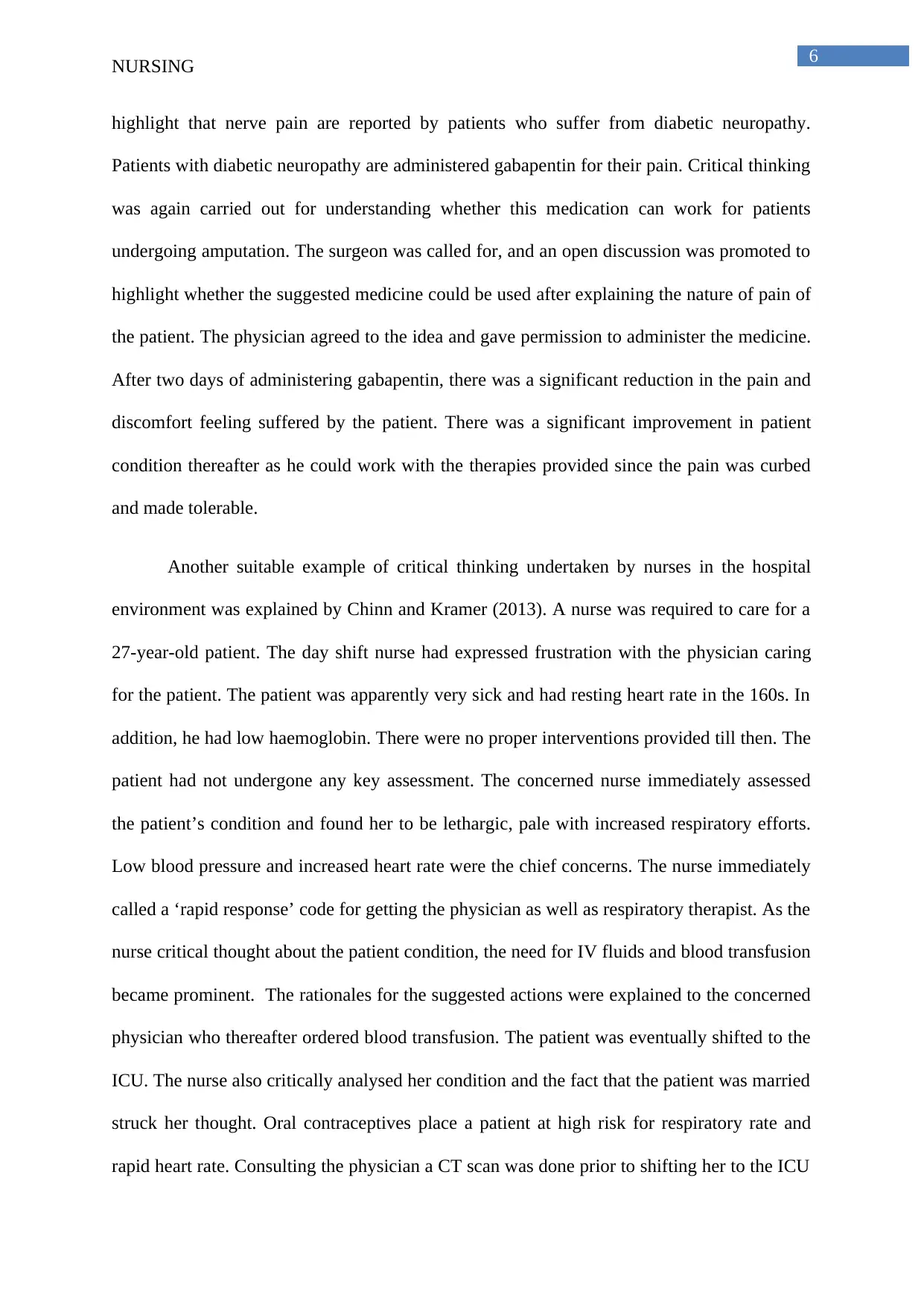
6
NURSING
highlight that nerve pain are reported by patients who suffer from diabetic neuropathy.
Patients with diabetic neuropathy are administered gabapentin for their pain. Critical thinking
was again carried out for understanding whether this medication can work for patients
undergoing amputation. The surgeon was called for, and an open discussion was promoted to
highlight whether the suggested medicine could be used after explaining the nature of pain of
the patient. The physician agreed to the idea and gave permission to administer the medicine.
After two days of administering gabapentin, there was a significant reduction in the pain and
discomfort feeling suffered by the patient. There was a significant improvement in patient
condition thereafter as he could work with the therapies provided since the pain was curbed
and made tolerable.
Another suitable example of critical thinking undertaken by nurses in the hospital
environment was explained by Chinn and Kramer (2013). A nurse was required to care for a
27-year-old patient. The day shift nurse had expressed frustration with the physician caring
for the patient. The patient was apparently very sick and had resting heart rate in the 160s. In
addition, he had low haemoglobin. There were no proper interventions provided till then. The
patient had not undergone any key assessment. The concerned nurse immediately assessed
the patient’s condition and found her to be lethargic, pale with increased respiratory efforts.
Low blood pressure and increased heart rate were the chief concerns. The nurse immediately
called a ‘rapid response’ code for getting the physician as well as respiratory therapist. As the
nurse critical thought about the patient condition, the need for IV fluids and blood transfusion
became prominent. The rationales for the suggested actions were explained to the concerned
physician who thereafter ordered blood transfusion. The patient was eventually shifted to the
ICU. The nurse also critically analysed her condition and the fact that the patient was married
struck her thought. Oral contraceptives place a patient at high risk for respiratory rate and
rapid heart rate. Consulting the physician a CT scan was done prior to shifting her to the ICU
NURSING
highlight that nerve pain are reported by patients who suffer from diabetic neuropathy.
Patients with diabetic neuropathy are administered gabapentin for their pain. Critical thinking
was again carried out for understanding whether this medication can work for patients
undergoing amputation. The surgeon was called for, and an open discussion was promoted to
highlight whether the suggested medicine could be used after explaining the nature of pain of
the patient. The physician agreed to the idea and gave permission to administer the medicine.
After two days of administering gabapentin, there was a significant reduction in the pain and
discomfort feeling suffered by the patient. There was a significant improvement in patient
condition thereafter as he could work with the therapies provided since the pain was curbed
and made tolerable.
Another suitable example of critical thinking undertaken by nurses in the hospital
environment was explained by Chinn and Kramer (2013). A nurse was required to care for a
27-year-old patient. The day shift nurse had expressed frustration with the physician caring
for the patient. The patient was apparently very sick and had resting heart rate in the 160s. In
addition, he had low haemoglobin. There were no proper interventions provided till then. The
patient had not undergone any key assessment. The concerned nurse immediately assessed
the patient’s condition and found her to be lethargic, pale with increased respiratory efforts.
Low blood pressure and increased heart rate were the chief concerns. The nurse immediately
called a ‘rapid response’ code for getting the physician as well as respiratory therapist. As the
nurse critical thought about the patient condition, the need for IV fluids and blood transfusion
became prominent. The rationales for the suggested actions were explained to the concerned
physician who thereafter ordered blood transfusion. The patient was eventually shifted to the
ICU. The nurse also critically analysed her condition and the fact that the patient was married
struck her thought. Oral contraceptives place a patient at high risk for respiratory rate and
rapid heart rate. Consulting the physician a CT scan was done prior to shifting her to the ICU
⊘ This is a preview!⊘
Do you want full access?
Subscribe today to unlock all pages.

Trusted by 1+ million students worldwide
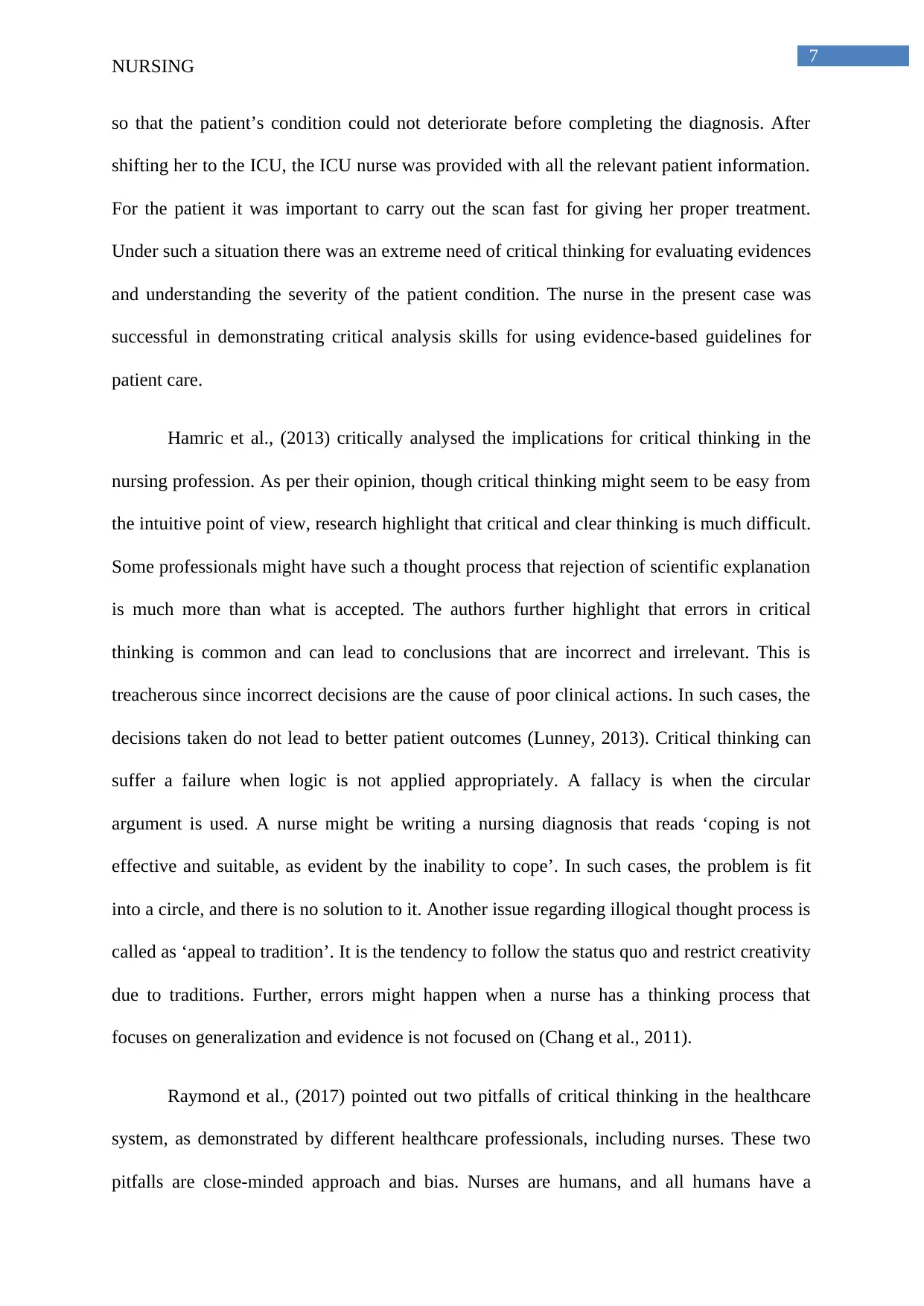
7
NURSING
so that the patient’s condition could not deteriorate before completing the diagnosis. After
shifting her to the ICU, the ICU nurse was provided with all the relevant patient information.
For the patient it was important to carry out the scan fast for giving her proper treatment.
Under such a situation there was an extreme need of critical thinking for evaluating evidences
and understanding the severity of the patient condition. The nurse in the present case was
successful in demonstrating critical analysis skills for using evidence-based guidelines for
patient care.
Hamric et al., (2013) critically analysed the implications for critical thinking in the
nursing profession. As per their opinion, though critical thinking might seem to be easy from
the intuitive point of view, research highlight that critical and clear thinking is much difficult.
Some professionals might have such a thought process that rejection of scientific explanation
is much more than what is accepted. The authors further highlight that errors in critical
thinking is common and can lead to conclusions that are incorrect and irrelevant. This is
treacherous since incorrect decisions are the cause of poor clinical actions. In such cases, the
decisions taken do not lead to better patient outcomes (Lunney, 2013). Critical thinking can
suffer a failure when logic is not applied appropriately. A fallacy is when the circular
argument is used. A nurse might be writing a nursing diagnosis that reads ‘coping is not
effective and suitable, as evident by the inability to cope’. In such cases, the problem is fit
into a circle, and there is no solution to it. Another issue regarding illogical thought process is
called as ‘appeal to tradition’. It is the tendency to follow the status quo and restrict creativity
due to traditions. Further, errors might happen when a nurse has a thinking process that
focuses on generalization and evidence is not focused on (Chang et al., 2011).
Raymond et al., (2017) pointed out two pitfalls of critical thinking in the healthcare
system, as demonstrated by different healthcare professionals, including nurses. These two
pitfalls are close-minded approach and bias. Nurses are humans, and all humans have a
NURSING
so that the patient’s condition could not deteriorate before completing the diagnosis. After
shifting her to the ICU, the ICU nurse was provided with all the relevant patient information.
For the patient it was important to carry out the scan fast for giving her proper treatment.
Under such a situation there was an extreme need of critical thinking for evaluating evidences
and understanding the severity of the patient condition. The nurse in the present case was
successful in demonstrating critical analysis skills for using evidence-based guidelines for
patient care.
Hamric et al., (2013) critically analysed the implications for critical thinking in the
nursing profession. As per their opinion, though critical thinking might seem to be easy from
the intuitive point of view, research highlight that critical and clear thinking is much difficult.
Some professionals might have such a thought process that rejection of scientific explanation
is much more than what is accepted. The authors further highlight that errors in critical
thinking is common and can lead to conclusions that are incorrect and irrelevant. This is
treacherous since incorrect decisions are the cause of poor clinical actions. In such cases, the
decisions taken do not lead to better patient outcomes (Lunney, 2013). Critical thinking can
suffer a failure when logic is not applied appropriately. A fallacy is when the circular
argument is used. A nurse might be writing a nursing diagnosis that reads ‘coping is not
effective and suitable, as evident by the inability to cope’. In such cases, the problem is fit
into a circle, and there is no solution to it. Another issue regarding illogical thought process is
called as ‘appeal to tradition’. It is the tendency to follow the status quo and restrict creativity
due to traditions. Further, errors might happen when a nurse has a thinking process that
focuses on generalization and evidence is not focused on (Chang et al., 2011).
Raymond et al., (2017) pointed out two pitfalls of critical thinking in the healthcare
system, as demonstrated by different healthcare professionals, including nurses. These two
pitfalls are close-minded approach and bias. Nurses are humans, and all humans have a
Paraphrase This Document
Need a fresh take? Get an instant paraphrase of this document with our AI Paraphraser

8
NURSING
certain scope for biases. Critical thinkers might be guided by such biases, and in this process,
the thinking process might get compromised. Biases are a prime cause of complicated patient
care. If a nurse thinks that a patient who is alcoholic acts as a manipulator, he might ignore
the complaints put forward by the patient that they are in pain and anxious. The signs of
delirium tremens might be missed in such cases. In addition, if a nurse is close-minded, the
situations can be highly unsafe. This is because other viewpoints are not considered in such
cases. In addition, essential and crucial input from other healthcare professionals or the
patient might be ignored if a nurse is close-minded.
Some of the noteworthy barriers to critical thinking have been illustrated in the works
of Maneval et al., (2011). These include self-focusing, face-saving, resistance to change,
conformity, stereotyping and self-deception. The personal factors that play a key role in
influencing critical thinking are age, moral development, emotional intelligence, self-
confidence, past experiences, knowledge of decision making process, interpersonal skills and
effective learning skills. The situational factors that have the power to guide critical thinking
include awareness of risks, anxiety, fatigue and stress, awareness of resources, positive
reinforcement and knowledge of related factors. Moreover, time limitations, the presence of
motivational factors, judgmental styles and environmental factors also influence nursing
critical thinking. Carter et al., (2016) in this context highlighted that certain habits and errors
might lead to uncritical or shallow decisions in place of judgments that are careful and
appropriate. These encompass resistance to change, conformity, ethnocentricity,
rationalization, oversimplification, unwarranted assumptions and underdeveloped common
sense. Ethnocentricity refers to the attitude that one’s own perceptions are supreme as
compared to others. Resistance to change is a result of anxiety and fear. Ego or face-saving
compels a nurse to preserve the image when reality comes as a threat. Under such situations,
the nurse is restricted from carrying out critical thinking. While simplification makes the
NURSING
certain scope for biases. Critical thinkers might be guided by such biases, and in this process,
the thinking process might get compromised. Biases are a prime cause of complicated patient
care. If a nurse thinks that a patient who is alcoholic acts as a manipulator, he might ignore
the complaints put forward by the patient that they are in pain and anxious. The signs of
delirium tremens might be missed in such cases. In addition, if a nurse is close-minded, the
situations can be highly unsafe. This is because other viewpoints are not considered in such
cases. In addition, essential and crucial input from other healthcare professionals or the
patient might be ignored if a nurse is close-minded.
Some of the noteworthy barriers to critical thinking have been illustrated in the works
of Maneval et al., (2011). These include self-focusing, face-saving, resistance to change,
conformity, stereotyping and self-deception. The personal factors that play a key role in
influencing critical thinking are age, moral development, emotional intelligence, self-
confidence, past experiences, knowledge of decision making process, interpersonal skills and
effective learning skills. The situational factors that have the power to guide critical thinking
include awareness of risks, anxiety, fatigue and stress, awareness of resources, positive
reinforcement and knowledge of related factors. Moreover, time limitations, the presence of
motivational factors, judgmental styles and environmental factors also influence nursing
critical thinking. Carter et al., (2016) in this context highlighted that certain habits and errors
might lead to uncritical or shallow decisions in place of judgments that are careful and
appropriate. These encompass resistance to change, conformity, ethnocentricity,
rationalization, oversimplification, unwarranted assumptions and underdeveloped common
sense. Ethnocentricity refers to the attitude that one’s own perceptions are supreme as
compared to others. Resistance to change is a result of anxiety and fear. Ego or face-saving
compels a nurse to preserve the image when reality comes as a threat. Under such situations,
the nurse is restricted from carrying out critical thinking. While simplification makes the
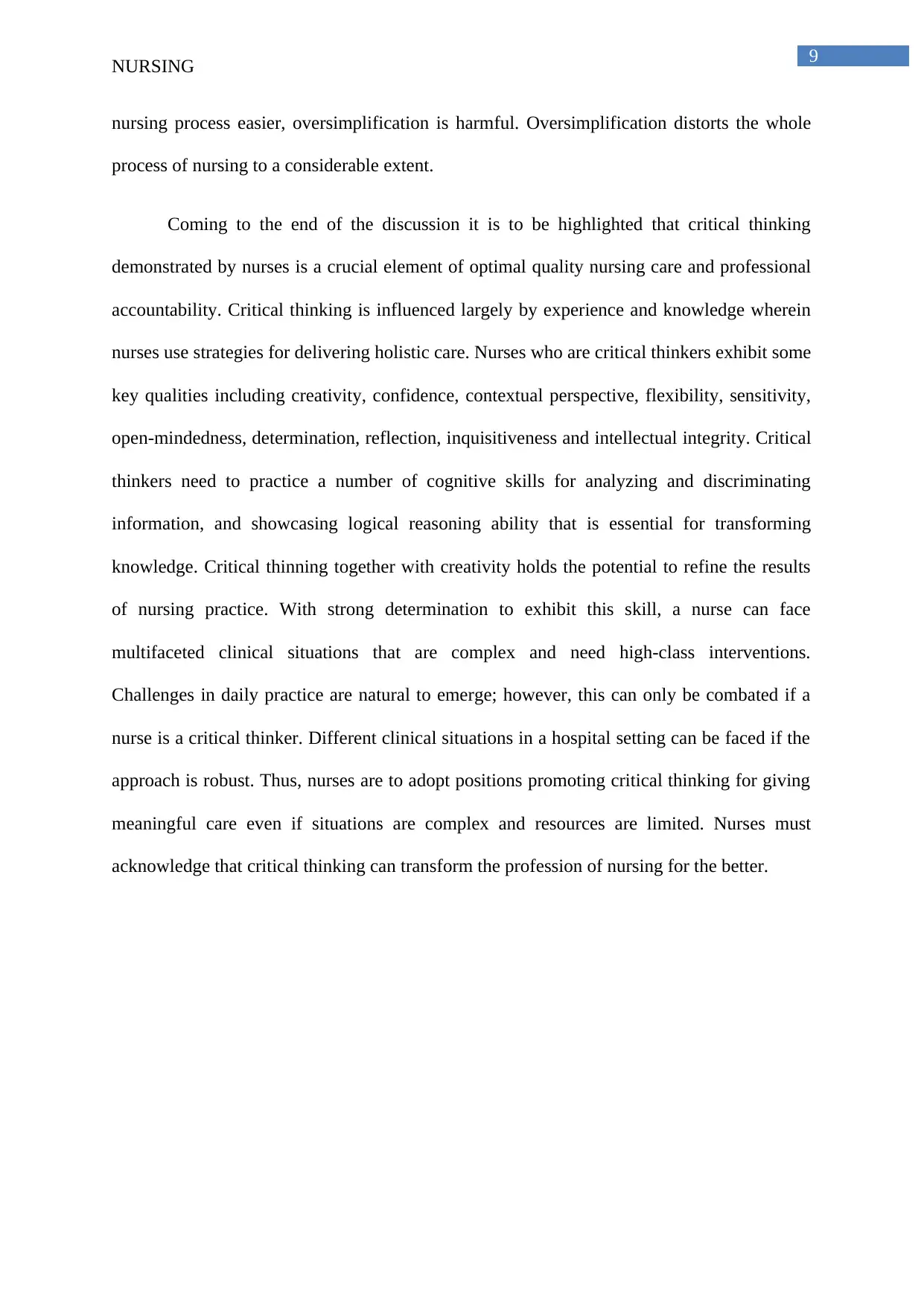
9
NURSING
nursing process easier, oversimplification is harmful. Oversimplification distorts the whole
process of nursing to a considerable extent.
Coming to the end of the discussion it is to be highlighted that critical thinking
demonstrated by nurses is a crucial element of optimal quality nursing care and professional
accountability. Critical thinking is influenced largely by experience and knowledge wherein
nurses use strategies for delivering holistic care. Nurses who are critical thinkers exhibit some
key qualities including creativity, confidence, contextual perspective, flexibility, sensitivity,
open-mindedness, determination, reflection, inquisitiveness and intellectual integrity. Critical
thinkers need to practice a number of cognitive skills for analyzing and discriminating
information, and showcasing logical reasoning ability that is essential for transforming
knowledge. Critical thinning together with creativity holds the potential to refine the results
of nursing practice. With strong determination to exhibit this skill, a nurse can face
multifaceted clinical situations that are complex and need high-class interventions.
Challenges in daily practice are natural to emerge; however, this can only be combated if a
nurse is a critical thinker. Different clinical situations in a hospital setting can be faced if the
approach is robust. Thus, nurses are to adopt positions promoting critical thinking for giving
meaningful care even if situations are complex and resources are limited. Nurses must
acknowledge that critical thinking can transform the profession of nursing for the better.
NURSING
nursing process easier, oversimplification is harmful. Oversimplification distorts the whole
process of nursing to a considerable extent.
Coming to the end of the discussion it is to be highlighted that critical thinking
demonstrated by nurses is a crucial element of optimal quality nursing care and professional
accountability. Critical thinking is influenced largely by experience and knowledge wherein
nurses use strategies for delivering holistic care. Nurses who are critical thinkers exhibit some
key qualities including creativity, confidence, contextual perspective, flexibility, sensitivity,
open-mindedness, determination, reflection, inquisitiveness and intellectual integrity. Critical
thinkers need to practice a number of cognitive skills for analyzing and discriminating
information, and showcasing logical reasoning ability that is essential for transforming
knowledge. Critical thinning together with creativity holds the potential to refine the results
of nursing practice. With strong determination to exhibit this skill, a nurse can face
multifaceted clinical situations that are complex and need high-class interventions.
Challenges in daily practice are natural to emerge; however, this can only be combated if a
nurse is a critical thinker. Different clinical situations in a hospital setting can be faced if the
approach is robust. Thus, nurses are to adopt positions promoting critical thinking for giving
meaningful care even if situations are complex and resources are limited. Nurses must
acknowledge that critical thinking can transform the profession of nursing for the better.
⊘ This is a preview!⊘
Do you want full access?
Subscribe today to unlock all pages.

Trusted by 1+ million students worldwide
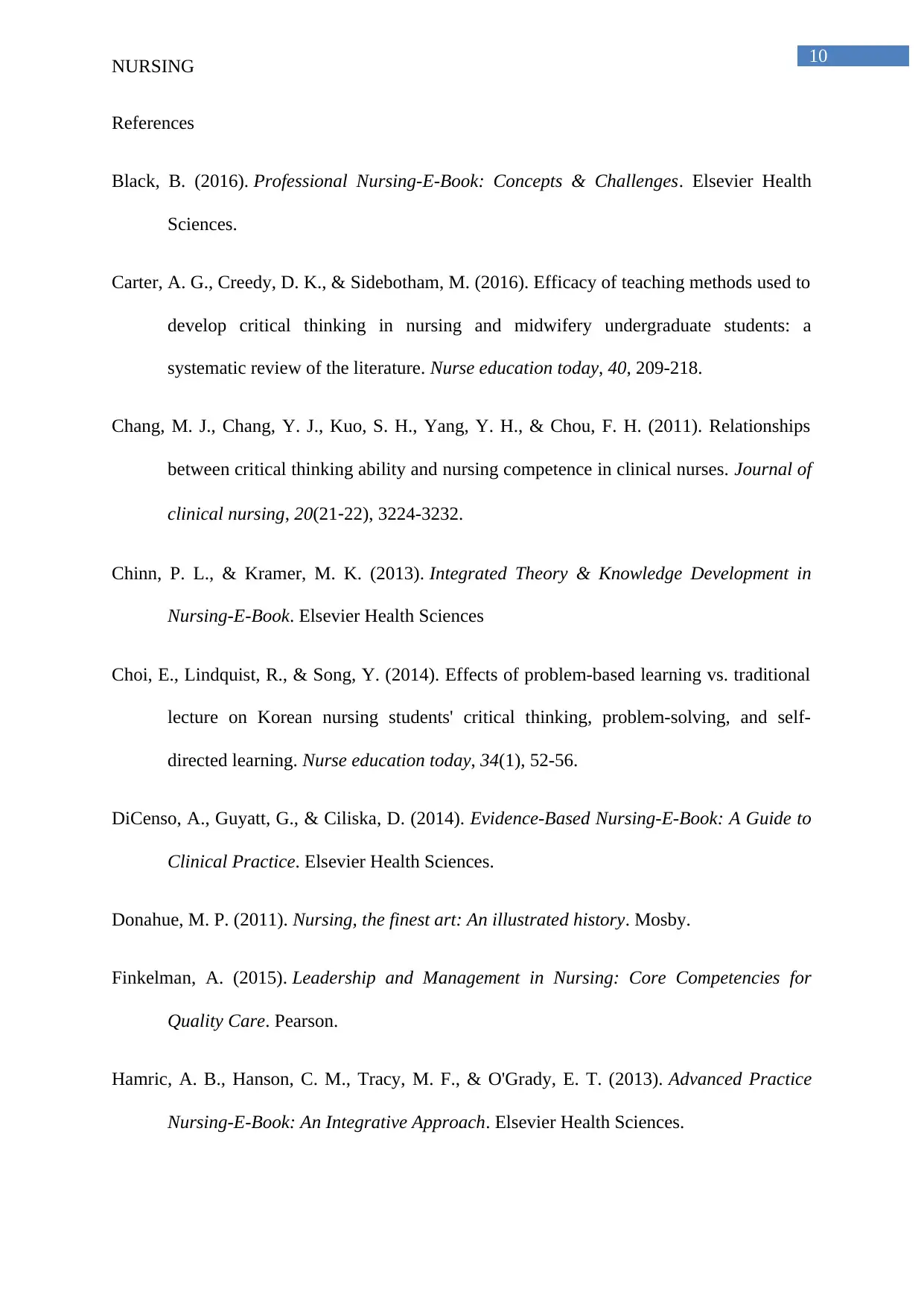
10
NURSING
References
Black, B. (2016). Professional Nursing-E-Book: Concepts & Challenges. Elsevier Health
Sciences.
Carter, A. G., Creedy, D. K., & Sidebotham, M. (2016). Efficacy of teaching methods used to
develop critical thinking in nursing and midwifery undergraduate students: a
systematic review of the literature. Nurse education today, 40, 209-218.
Chang, M. J., Chang, Y. J., Kuo, S. H., Yang, Y. H., & Chou, F. H. (2011). Relationships
between critical thinking ability and nursing competence in clinical nurses. Journal of
clinical nursing, 20(21‐22), 3224-3232.
Chinn, P. L., & Kramer, M. K. (2013). Integrated Theory & Knowledge Development in
Nursing-E-Book. Elsevier Health Sciences
Choi, E., Lindquist, R., & Song, Y. (2014). Effects of problem-based learning vs. traditional
lecture on Korean nursing students' critical thinking, problem-solving, and self-
directed learning. Nurse education today, 34(1), 52-56.
DiCenso, A., Guyatt, G., & Ciliska, D. (2014). Evidence-Based Nursing-E-Book: A Guide to
Clinical Practice. Elsevier Health Sciences.
Donahue, M. P. (2011). Nursing, the finest art: An illustrated history. Mosby.
Finkelman, A. (2015). Leadership and Management in Nursing: Core Competencies for
Quality Care. Pearson.
Hamric, A. B., Hanson, C. M., Tracy, M. F., & O'Grady, E. T. (2013). Advanced Practice
Nursing-E-Book: An Integrative Approach. Elsevier Health Sciences.
NURSING
References
Black, B. (2016). Professional Nursing-E-Book: Concepts & Challenges. Elsevier Health
Sciences.
Carter, A. G., Creedy, D. K., & Sidebotham, M. (2016). Efficacy of teaching methods used to
develop critical thinking in nursing and midwifery undergraduate students: a
systematic review of the literature. Nurse education today, 40, 209-218.
Chang, M. J., Chang, Y. J., Kuo, S. H., Yang, Y. H., & Chou, F. H. (2011). Relationships
between critical thinking ability and nursing competence in clinical nurses. Journal of
clinical nursing, 20(21‐22), 3224-3232.
Chinn, P. L., & Kramer, M. K. (2013). Integrated Theory & Knowledge Development in
Nursing-E-Book. Elsevier Health Sciences
Choi, E., Lindquist, R., & Song, Y. (2014). Effects of problem-based learning vs. traditional
lecture on Korean nursing students' critical thinking, problem-solving, and self-
directed learning. Nurse education today, 34(1), 52-56.
DiCenso, A., Guyatt, G., & Ciliska, D. (2014). Evidence-Based Nursing-E-Book: A Guide to
Clinical Practice. Elsevier Health Sciences.
Donahue, M. P. (2011). Nursing, the finest art: An illustrated history. Mosby.
Finkelman, A. (2015). Leadership and Management in Nursing: Core Competencies for
Quality Care. Pearson.
Hamric, A. B., Hanson, C. M., Tracy, M. F., & O'Grady, E. T. (2013). Advanced Practice
Nursing-E-Book: An Integrative Approach. Elsevier Health Sciences.
Paraphrase This Document
Need a fresh take? Get an instant paraphrase of this document with our AI Paraphraser
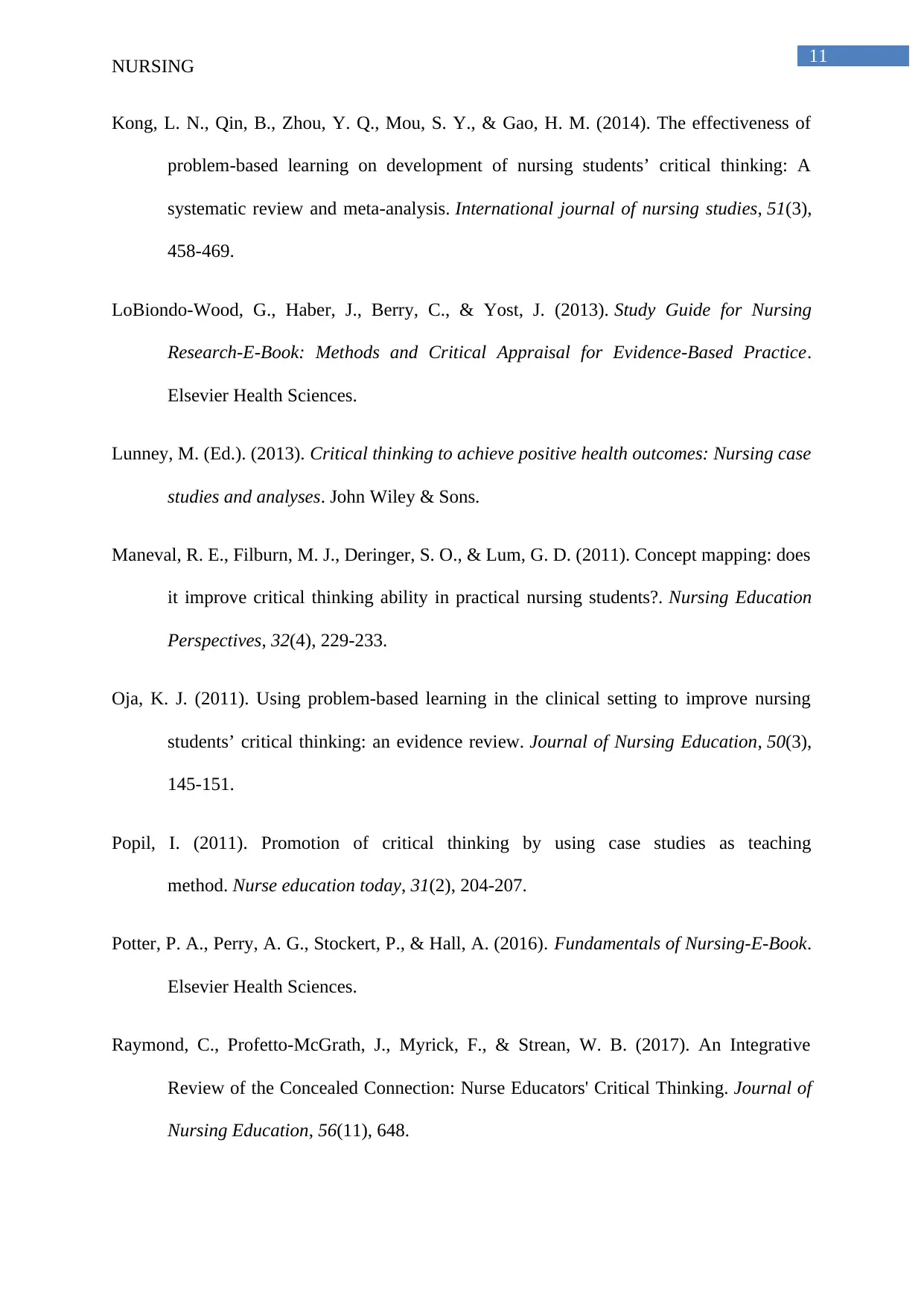
11
NURSING
Kong, L. N., Qin, B., Zhou, Y. Q., Mou, S. Y., & Gao, H. M. (2014). The effectiveness of
problem-based learning on development of nursing students’ critical thinking: A
systematic review and meta-analysis. International journal of nursing studies, 51(3),
458-469.
LoBiondo-Wood, G., Haber, J., Berry, C., & Yost, J. (2013). Study Guide for Nursing
Research-E-Book: Methods and Critical Appraisal for Evidence-Based Practice.
Elsevier Health Sciences.
Lunney, M. (Ed.). (2013). Critical thinking to achieve positive health outcomes: Nursing case
studies and analyses. John Wiley & Sons.
Maneval, R. E., Filburn, M. J., Deringer, S. O., & Lum, G. D. (2011). Concept mapping: does
it improve critical thinking ability in practical nursing students?. Nursing Education
Perspectives, 32(4), 229-233.
Oja, K. J. (2011). Using problem-based learning in the clinical setting to improve nursing
students’ critical thinking: an evidence review. Journal of Nursing Education, 50(3),
145-151.
Popil, I. (2011). Promotion of critical thinking by using case studies as teaching
method. Nurse education today, 31(2), 204-207.
Potter, P. A., Perry, A. G., Stockert, P., & Hall, A. (2016). Fundamentals of Nursing-E-Book.
Elsevier Health Sciences.
Raymond, C., Profetto-McGrath, J., Myrick, F., & Strean, W. B. (2017). An Integrative
Review of the Concealed Connection: Nurse Educators' Critical Thinking. Journal of
Nursing Education, 56(11), 648.
NURSING
Kong, L. N., Qin, B., Zhou, Y. Q., Mou, S. Y., & Gao, H. M. (2014). The effectiveness of
problem-based learning on development of nursing students’ critical thinking: A
systematic review and meta-analysis. International journal of nursing studies, 51(3),
458-469.
LoBiondo-Wood, G., Haber, J., Berry, C., & Yost, J. (2013). Study Guide for Nursing
Research-E-Book: Methods and Critical Appraisal for Evidence-Based Practice.
Elsevier Health Sciences.
Lunney, M. (Ed.). (2013). Critical thinking to achieve positive health outcomes: Nursing case
studies and analyses. John Wiley & Sons.
Maneval, R. E., Filburn, M. J., Deringer, S. O., & Lum, G. D. (2011). Concept mapping: does
it improve critical thinking ability in practical nursing students?. Nursing Education
Perspectives, 32(4), 229-233.
Oja, K. J. (2011). Using problem-based learning in the clinical setting to improve nursing
students’ critical thinking: an evidence review. Journal of Nursing Education, 50(3),
145-151.
Popil, I. (2011). Promotion of critical thinking by using case studies as teaching
method. Nurse education today, 31(2), 204-207.
Potter, P. A., Perry, A. G., Stockert, P., & Hall, A. (2016). Fundamentals of Nursing-E-Book.
Elsevier Health Sciences.
Raymond, C., Profetto-McGrath, J., Myrick, F., & Strean, W. B. (2017). An Integrative
Review of the Concealed Connection: Nurse Educators' Critical Thinking. Journal of
Nursing Education, 56(11), 648.
1 out of 11
Related Documents
Your All-in-One AI-Powered Toolkit for Academic Success.
+13062052269
info@desklib.com
Available 24*7 on WhatsApp / Email
![[object Object]](/_next/static/media/star-bottom.7253800d.svg)
Unlock your academic potential
Copyright © 2020–2025 A2Z Services. All Rights Reserved. Developed and managed by ZUCOL.





